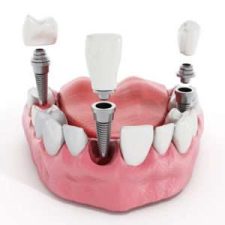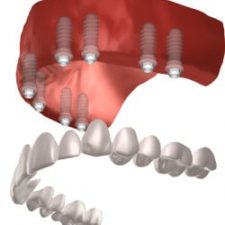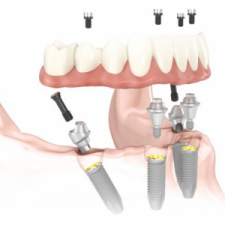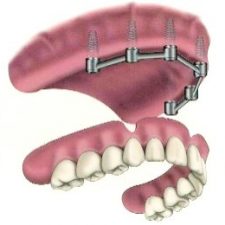Dental Implants
Are you missing a tooth and looking for a replacement?
You may now consider replacing the tooth with an advanced dental implant system from Germany.
Whether your missing tooth is the result of gum disease, tooth decay or an injury, we will help restore your beautiful smile with a new dental implant!
Dental implants are the number one solution for restoring a missing tooth. There are many benefits of having a dental implant. It looks and feels like a natural tooth, it’s easy to take care of and it’s a lifetime solution.
Dental implants are the number one solution for restoring a missing tooth. There are many benefits of having a dental implant. It looks and feels like a natural tooth, it’s easy to take care of and it’s a lifetime solution.
Advantages of Dental Implants
- Comfort – Dental implants are far more comfortable than removable dentures. They look and feel like natural teeth. They integrate with your bone so they become permanent. Unlike dentures there is no fear of a loose fit or being displaced when you eat, talk or laugh.
- Better appearance – Dental implants allow you to retain your natural face shape and smile. It provides a natural looking smile and functionality.
- Prevents bone loss – Losing one or more teeth can lead to loss of bone in that particular area of the jaw. When our jawbone has no teeth, it loses volume and shrinks. Dental implants, when placed in the jaw bone, preserves and stimulates natural bone, and prevent bone loss.
- Protects healthy teeth – A fixed dental bridge requires the support of the teeth adjacent to the missing teeth space, this needs shaping of an otherwise healthy teeth. Whereas, dental implants are fixed the jawbone where your missing tooth root was, without damaging healthy teeth. Dental implants also prevent adjacent teeth from tipping into the space left open by a missing tooth or teeth.
Dental Implant Treatment Options
Dental Implant Procedure
Dental implants can replace a single missing tooth, or can be used as an anchor for a bridge to replace multiple missing teeth. Because the implant is secured deep into your jawbone, the final tooth replacement usually lasts longer and is more solid and secure than traditional dentures. Here we provide a step-by-step guide to the dental implant procedure.
Step 1: Assessing and preparing the dental implant site Because dental implants are fitted into your jawbone, your dentist will need to check the condition of the bone site and make sure there’s enough bone to hold the implant securely. Your dentist will also use x-rays to check for nearby blood vessels and nerves. 3D CBCT X-rays are used to assess the density of bone available to place an implant. If you don’t have enough bone in your jaw to accommodate the implant successfully, your dentist will discuss options with you. This may involve bone-grafting, using synthetic bone, or a process called ‘bone distraction’ – a special procedure which will help your body create new bone on the implant site. If this is necessary, it will simply take a little longer before your new implant can be fitted. At your first surgical visit, your dentist will anaesthetize the implant site before removing gum tissue to expose the bone underneath. This may be done either with a scalpel, or, in some cases, a special ‘punch’ which is a less invasive way of accessing the bone.
Step 2: Positioning the implant Your dentist will make a pilot hole in the bone of the implant site. Precise positioning of the implants is done using 3D printed surgical guides. The hole will initially be drilled just half-way, and an alignment pin will be used to make sure the hole is at the right depth and angle to accommodate the new dental implant. Once the dentist is satisfied with the alignment, a series of increasingly larger drills will be used to widen the hole to the correct size.
Step 3: Placing the implant The implants are then screwed tightly into the bone. Once the implant is screwed into place, a covering for the implant is used to seal the implant site from the rest of the mouth. This will help the gum to heal around the new implant safely. Healing times can vary, depending on the position of the implant site and the techniques used to access the bone. Any stitches used to help position the gum around the implant cap are usually ready to be removed between 7 and 10 days, although it may take 3 to 6 months before the implant is ready to receive its final prosthetic tooth. This is because the bone and the implant must completely ‘osseointegrate’ before the final work – otherwise pressure and movement could disrupt the healing of the new implant. Implants can also be placed and restored in a single sitting using immediate loading basal implants.
Step 4: Creating your new tooth The final step is split into two parts. After the implant securely fuses with the bone, the implant cap will be removed and an ‘abutment’ will be attached to the top of the implant. Then, depending on whether you’re replacing a single tooth or multiple teeth, either a crown or bridge will be fitted on top of the abutment. The crown or bridge will be carefully prepared to match the colour, shape and size of your natural teeth. These stages may be carried out either together or separately, depending on the complexity of your treatment, but your dentist will be able to advise. Your dentist will schedule future appointments to monitor your new implant regularly and also explain exactly how to care for your implant, Dental implants are a reliable, long-lasting solution for missing teeth which bring a range of benefits. If you would like to find out more about the costs of the procedure, or why we recommend implants as a first choice solution for missing teeth, contact us today for a no-obligation discussion.
Step 1: Assessing and preparing the dental implant site Because dental implants are fitted into your jawbone, your dentist will need to check the condition of the bone site and make sure there’s enough bone to hold the implant securely. Your dentist will also use x-rays to check for nearby blood vessels and nerves. 3D CBCT X-rays are used to assess the density of bone available to place an implant. If you don’t have enough bone in your jaw to accommodate the implant successfully, your dentist will discuss options with you. This may involve bone-grafting, using synthetic bone, or a process called ‘bone distraction’ – a special procedure which will help your body create new bone on the implant site. If this is necessary, it will simply take a little longer before your new implant can be fitted. At your first surgical visit, your dentist will anaesthetize the implant site before removing gum tissue to expose the bone underneath. This may be done either with a scalpel, or, in some cases, a special ‘punch’ which is a less invasive way of accessing the bone.
Step 2: Positioning the implant Your dentist will make a pilot hole in the bone of the implant site. Precise positioning of the implants is done using 3D printed surgical guides. The hole will initially be drilled just half-way, and an alignment pin will be used to make sure the hole is at the right depth and angle to accommodate the new dental implant. Once the dentist is satisfied with the alignment, a series of increasingly larger drills will be used to widen the hole to the correct size.
Step 3: Placing the implant The implants are then screwed tightly into the bone. Once the implant is screwed into place, a covering for the implant is used to seal the implant site from the rest of the mouth. This will help the gum to heal around the new implant safely. Healing times can vary, depending on the position of the implant site and the techniques used to access the bone. Any stitches used to help position the gum around the implant cap are usually ready to be removed between 7 and 10 days, although it may take 3 to 6 months before the implant is ready to receive its final prosthetic tooth. This is because the bone and the implant must completely ‘osseointegrate’ before the final work – otherwise pressure and movement could disrupt the healing of the new implant. Implants can also be placed and restored in a single sitting using immediate loading basal implants.
Step 4: Creating your new tooth The final step is split into two parts. After the implant securely fuses with the bone, the implant cap will be removed and an ‘abutment’ will be attached to the top of the implant. Then, depending on whether you’re replacing a single tooth or multiple teeth, either a crown or bridge will be fitted on top of the abutment. The crown or bridge will be carefully prepared to match the colour, shape and size of your natural teeth. These stages may be carried out either together or separately, depending on the complexity of your treatment, but your dentist will be able to advise. Your dentist will schedule future appointments to monitor your new implant regularly and also explain exactly how to care for your implant, Dental implants are a reliable, long-lasting solution for missing teeth which bring a range of benefits. If you would like to find out more about the costs of the procedure, or why we recommend implants as a first choice solution for missing teeth, contact us today for a no-obligation discussion.
Dental implants treatment at Aspen Dental Care are performed by experienced and renowned dental surgeons who have been in practice since 20 years. They are internationally trained to perform complicated surgeries including implant placement. We use dental implant systems like Ankylos from Germany, Bio Horizon from USA, Nobel Bio Care from Switzerland and Bio Denta from Switzerland.
Dental Implant Recovery
Follow these important tips for speedy recovery after the treatment:
- Take complete rest for a day or two after surgery.
- Bleeding and swelling are likely to occur and this is normal. Use cold compress on the cheek to reduce swelling and pain.
- Eat soft foods that requires very little chewing.
- Don’t miss out to take any medications prescribed by the surgeon.
- Do not proceed with brushing and flossing right way. Use mouthwash to maintain oral hygiene for an initial few days.
- If you notice any unusual symptoms, contact your dentist.
Caring for Dental Implants
Different dental implants may require different care. Your dentist will ensure you are equipped with the correct products, such as special brushes, to care for your implants.
Maintaining good oral hygiene is necessary for preventing infection around your dental implant. With good maintenance and scheduled visits to your dentist for professional cleaning, your dental implants will last for many years to come.
Maintaining good oral hygiene is necessary for preventing infection around your dental implant. With good maintenance and scheduled visits to your dentist for professional cleaning, your dental implants will last for many years to come.
Frequently Asked Questions
What is a dental implant?
A dental implant is an artificial tooth root made of titanium that is surgically anchored to your jaw to hold a replacement tooth or bridge in place.. It is inserted into jaw at the site of the missing tooth. After the healing process, a crown is placed over the implant.
Dental implants are a natural looking solution to replace missing teeth.Implants are also a great solution for patients who are experiencing weak or failing teeth, if their bone structure is still intact. A dental implant can help support a healthy smile.
When might I need a dental implant?
Implants are not just for missing teeth. Sometimes, weak or failing teeth can be better candidates for implant replacement because they still have bone left. A dental implant can not only replace a single or several missing teeth but also be used to support a denture in people who have lost all their teeth.
Are you a good candidate for a dental implant?
Dental implants are usually a recommended option for anyone missing one or more teeth. Your dentist may recommend you as a candidate for a dental implant if you have proper bone structure, healthy gums, or who have ill-fitting dentures.
If you suffer from chronic problems such as clenching, grinding, or suffer from diabetes, success rates may decrease. We may also recommend bone grafting procedures to add bone before an implant occurs.
If you suffer from chronic problems such as clenching, grinding, or suffer from diabetes, success rates may decrease. We may also recommend bone grafting procedures to add bone before an implant occurs.
How long does the process take?
The process usually takes around 3 to 6 months to complete. If bone grafting is necessary, further time may be required. Each patient has different bone quality and each heals differently, and so treatment times will vary.
After the surgical placement of the implants, the healing process can take up to six months. The fitting and adjustment of replacement teeth typically take no more than two months.
After the surgical placement of the implants, the healing process can take up to six months. The fitting and adjustment of replacement teeth typically take no more than two months.
Are dental implants safe?
At Aspen Dental Care we use top quality dental implants only. Dental implants have been used for many years and are proven to be a safe and effective solution for replacing teeth . They are Made from materials that are biocompatible and is a strong and safe foundation for replacing missing teeth
Are there any risks, side effects or pain involved?
Any risks and side effects are rare and easily treated. These can include:
- Infection
- Injury or damage to other teeth or blood vessels
- Nerve damage
- Risk of perforating sinus in upper jaw implant
How long do dental implants last?
Your dental implant should last a lifetime if taken care off properly. The artificial replacement tooth attached to the dental implant, does have a lifespan, which is generally between 5-15 years depending on how well it is cared for.




